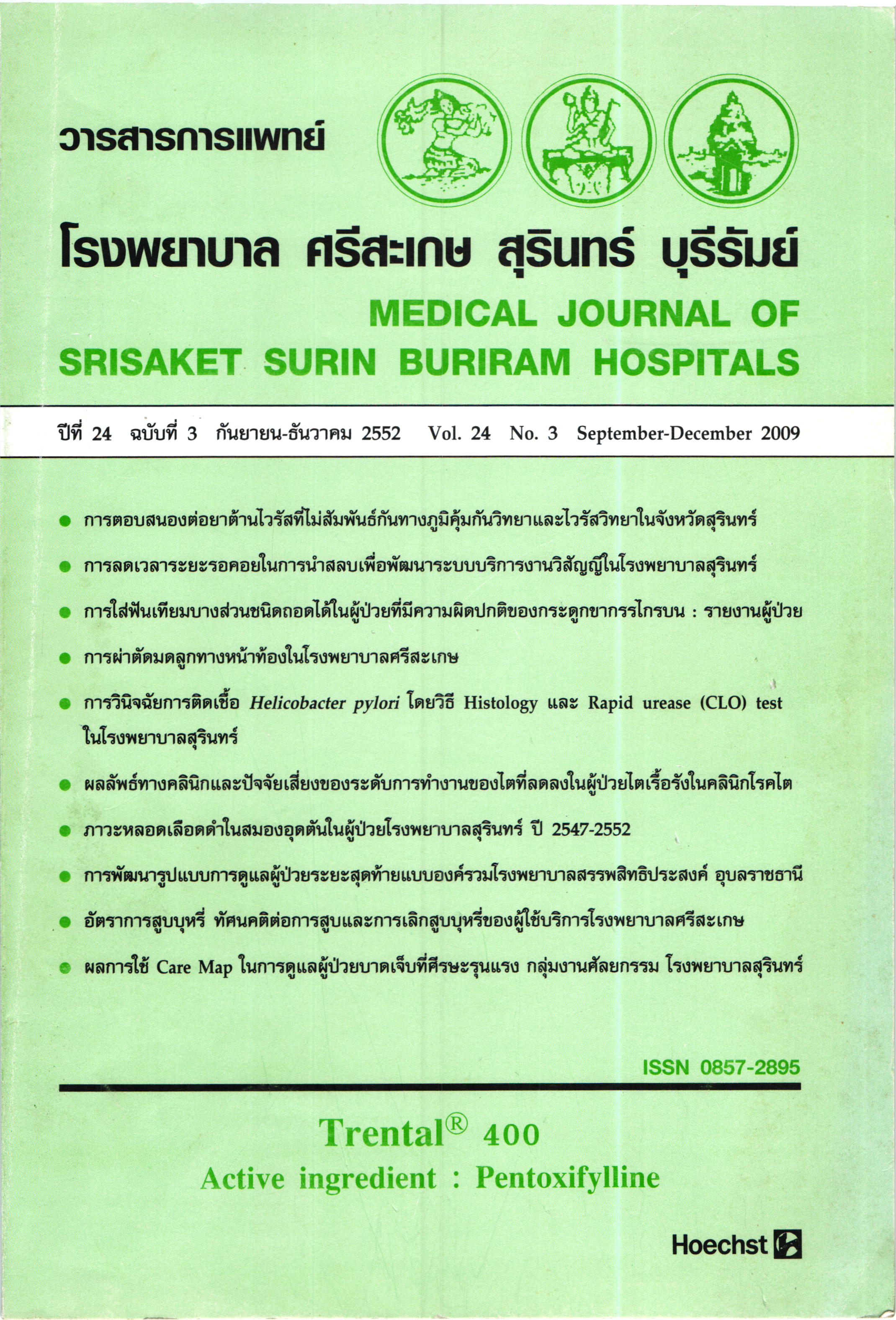การวินิจฉัยการติดเชื้อ Helicobacter pylori โดยวิธี Histology และ Rapid urease (CLO) test ในโรงพยาบาลสุรินทร์
Main Article Content
บทคัดย่อ
หลักการและเหตุผล: การติดเชื้อ H. pylori เป็นสาเหตุสำคัญของโรคแผลในกระเพาะอาหาร เพราะ ฉะนั้นถ้าสามารถวินิจฉัยและรักษาการติดเชื้อ H. pylori ได้จะทำให้ปัญหาและ ภาวะแทรกซ้อนที่เกิดจากแผลในกระเพาะอาหารนั้นลดลง
วัตถุประสงค์: เพี่อศึกษาค่า sensitivity และ specificity ระหว่างการวินิจฉัยการติดเชื้อH. pylori โดยวิธี Histology และ Rapid urease (CLO) test และศึกษา ค่าใช้จ่ายของการส่งตรวจแต่ละวิธี
รูปแบบการวิจัย: การศึกษาแบบย้อนหลัง
วิชีการวิจัย: ทำการรวบรวมข้อมูลผู้ป่วยที่เข้ารับการส่องกล้องทางเดินอาหารส่วนบนและมีการวินิจฉัยการติดเชื้อ H. pylori โดยวิธีการตรวจทาง Histology และ Rapid urease (CLO) test ตั้งแต่เดือนพฤศจิกายน 2551 จนถึงเดือนตุลาคม 2552
ผลการวิจัย: ผู้ป่วย 544 ราย ที่รวบรวมจากการศึกษานี้มีค่าเฉลี่ยของอายุเท่ากับ 60.34 ปี ตรวจพบการติดเชื้อ H. pylori ทั้งหมดเป็นจำนวน 370 ราย (68%) โดยผล การตรวจทาง Histology เป็นบวก 326 ราย คิดเป็น 88.1% ของผู้ป่วยที่ติดเชื้อ H. pylori ส่วนผลการตรวจ Rapid urease (CLO) test เป็นบวก 164 ราย คิดเป็น 44.3% ค่า sensitivity ของการตรวจ Rapid urease (CLO) test และ Histology เท่ากับ 44.32% และ 88.11% ตามลำดับ ซึ่งพบว่ามีความแตกต่างกัน อย่างมีนัยสำคัญทางสถิติ (p-value < 0.001)
สรุป: การตรวจหาการติดเชื้อ H. pylori ในโรงพยาบาลสุรินทร์โดยวิธี Histology มีความไวในการตรวจดีกว่า การตรวจโดยวิธี Rapid urease (CLO) test
Article Details
References
Dempsey DT. Stomach. In : Brunicardi FC, Andersen DK. Billiar TR. Dunn DL, Hunter JG. Matthews JB. et al. Schwartz's principle of Surgery. 9th ed. New York : Mc Graw Hill ; 2009:889-948.
Lena Napolitano. Refractory Peptic Ulcer Disease. Gastroenterol Clin N Am 2009;38:267-88.
Ramakrishnan K. Peptic Ulcer Disease. American Family Physician 2007;76(7):1005-12.
Saad RJ. Scheiman JM. Diagnosis and Management of Peptic Ulcer Disease. Gastroenterology 2004;6(3):569-87.
Adrienne Z. Abies, I. Simon, Emily R. Melton. Update on Helicobacter pylori Treatment. American Family Physician 2007;75(3):351-58.
Leong RW. Differences in Peptic Ulcer Between the East and the West. Gastroenterol Clin N Am 2009;38:363-79.
Chu Kent-Man, Poon Ronnie, Tuen Henry H, Law Simon YK, Branicki frank J, Wong John. A prospective comparison of locally made rapid urease test and histology of Helico bacter pylori infection. Gastrointestinal Endoscopy 1997;46(6):503-6.
Nishikawa Keiko, Sugiyama Toshiro, Kato Mototsugu, Ishizuka Jun, Kagaya Hidetoshi, Hokari Kaku. et al. A prospective evaluation of new rapid urease tests before and after eradication treatment of Helicobacter pylori, in comparison with histology, culture and 13C-urea breath test. Gastrointestinal Endoscopy 2000;51(2):164-8.
Lee JM, Breslin NP, Fallon C, et al. Rapid urease tests lack sensitivity in Helicobacter pylori diagnosis when peptic ulcer disease presents with bleeding. AM J Gastroenterol 2000;95:1166-70
Tu Tien-Chien, Lee, Chia-Long, Wu, Chi- Hwa. Chen Tzen-kwan, Chan Chung- Chuan. Huang Shin-Hung, et al. Comparison of invasive and noninvasive tests for detecting Helicobacter pylori infection in bleeding peptic ulcers. Gastrointestinal Endoscopy 1999;49(3):302-6.
Laine LA, Nathwani RA, Naritoku W. The effect of GI bleeding on Helicobacter pylori diagnostic testing: a prospective study at the time of bleeding and 1 month later. Gastrointestinal Endoscopy 2005;62(6):853-9.
Hahn M, Fennerty MB, Corless CL, et al. Noninvasive tests as a substitute for histology in the diagnosis of Helicobacter pylon infection. Gastrointestinal Endoscopy 2000;52(1):20-6.

